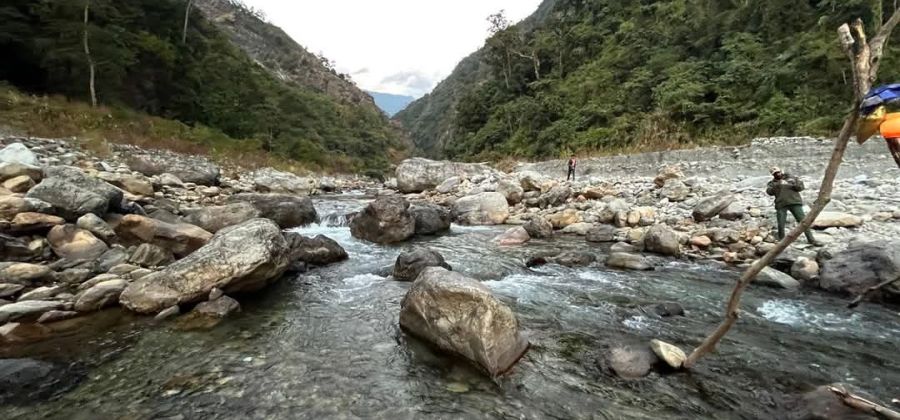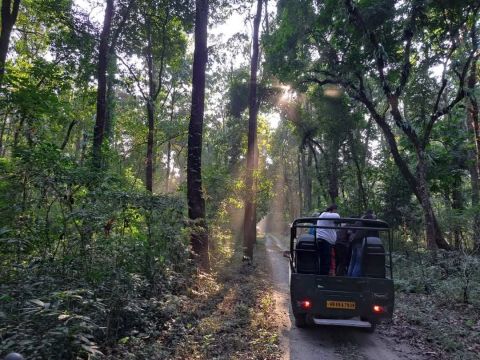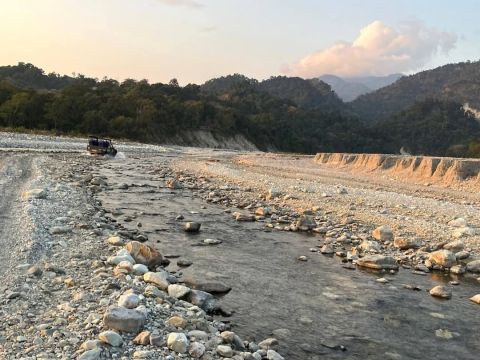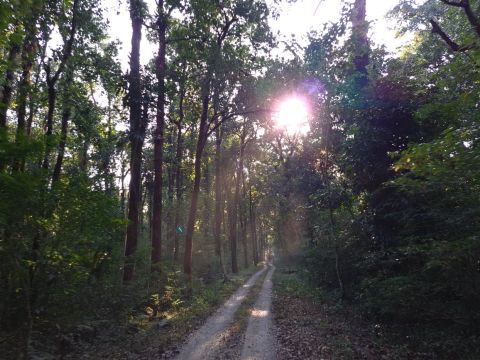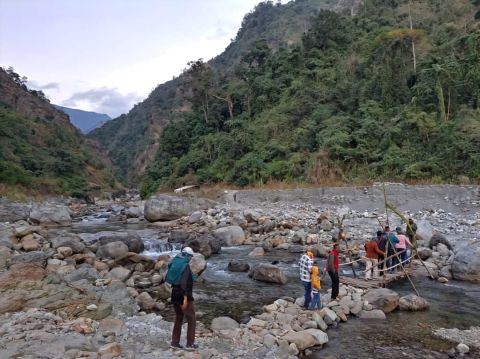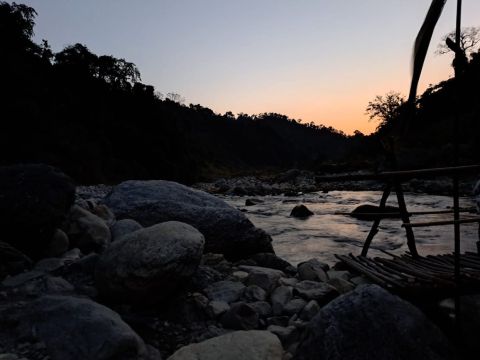Whispers of the Wild: A Day in Buxa Tiger Reserve
A memorable journey through the wilderness of Buxa Tiger Reserve, filled with adventure and unexpected encounters.

This travelogue recounts an adventurous day trip to a wildlife sanctuary along the international border between India and Bhutan. Buxa Tiger Reserve, located in the northern region of West Bengal, is a stunning blend of forests, rivers, and hills.
We went to Jayanti, a beautiful forest village situated on the banks of the Jayanti River inside the Buxa Tiger Reserve, for a day trip. Buxa Tiger Reserve shares its border with the Phibsoo Wildlife Sanctuary of Bhutan to the north and Manas National Park of Assam to the east, serving as an international corridor for the migration of Asian elephants between India and Bhutan. The forest is home to a variety of wildlife, including Asian elephants, gaurs, sambar deer, clouded leopards, Indian leopards, and the rarely spotted Royal Bengal tiger. Around 230 species of birds, including hornbills, as well as endangered species like the regal python, can also be found in this forest.
This is the perfect place if you’re looking for thrilling activities amidst breathtaking nature. The activities include a jeep safari through the deep, dense forests of Buxa Tiger Reserve to spot wildlife, a safari and trek to the Mahakal Temple Cave—located within Bhutan’s territory—which passes through the rocky white riverbed of the Jayanti River and dense forests, and trekking to Pukhuri Hill.
Since it’s not a very popular tourist destination outside West Bengal, I’d like to provide all the details of how to reach there at the beginning. If you’re planning a trip to Darjeeling or Sikkim, I’d highly recommend including Buxa Tiger Reserve in your tour itinerary.
The nearest airport is Bagdogra International Airport in Siliguri, approximately 160 km from Jayanti. You can hire a cab from Bagdogra Airport to reach Alipurduar, the nearest town to Jayanti and a district town in West Bengal.
The nearest railway station is Alipurduar Junction. Jayanti is also well-connected to cities like Kolkata, Guwahati, and Siliguri by road. From Alipurduar, you can hire a cab, taxi, or shared vehicle to reach Jayanti.
There are plenty of accommodation options, including homestays and resorts, in Jayanti. You can also stay in Alipurduar and plan a day trip to Jayanti. However, the advantage of staying in Jayanti is that most resorts and homestays offer tour packages that includes the necessary permits and safari arrangements.
The safari jeeps are operated by the local forest department, and a guide is usually included with each safari. The guides not only ensure your safety during the journey but also provide insightful information about the region’s wildlife.
It is important to note that permits are mandatory for safaris and trekking, as Jayanti is located inside the Buxa Tiger Reserve. You can obtain entry permits from Rajabhatkhawa, near Alipurduar, or directly from the forest checkpoint in Jayanti.
To secure a permit, you’ll need to carry a valid ID proof. If you’re planning to stay overnight in Jayanti, you’ll also need to provide details of your accommodation along with your itinerary.
The entry fee for visiting Jayanti is ₹120 per person. If you're bringing a private vehicle, there is an additional vehicle fee of ₹400 per vehicle.
You can also book safari tickets at the forest checkpoint. The cost for a jeep safari is ₹1,200 per safari.
We started our journey early in the morning and stopped for breakfast at a small restaurant in a suburban town in the northern part of West Bengal. The food was fresh, and we enjoyed some delicious sweets made from pure cow’s milk. However, we accidentally took the wrong road, which delayed us by about 1hr, leading us near the Buxa picnic spot. On our left, we could see the picturesque hills of Bhutan, while lush tea gardens stretched out on our right. Everyone was captivated by the scenic beauty, but I was too anxious about being late for the safari to fully appreciate it.
Finally, we arrived at the Jayanti checkpoint around 12:30 PM. Since it was 25th December, the area was a bit crowded, and we had to wait for about 15–20 minutes to get our entry permits. Fortunately, we had booked our safari in advance, so I called the driver to inform him that we had reached the checkpoint. He suggested that we have our lunch and report back exactly at 2 PM.
The first thing I noticed after stepping onto the Jayanti riverbed was the green Himalayan mountain range rising behind the dazzling white stretch of the riverbed. Interestingly, even on Google Maps, the riverbed appears white. This striking color comes from the pebbles, stones, and sand composed of materials like quartz and limestone. These pebbles and rocks have been eroded from the surrounding Himalayan hills. Their bright appearance is due to the reflection of sunlight on the stones, which are naturally polished by the continuous flow of the river.
Since I had already pre-ordered our lunch at one of the homestays, the food was served promptly at their restaurant as soon as we arrived. The meal was delicious, but I would recommend avoiding fish dishes in Jayanti. I had heard from others—and also experienced it myself—that the fish isn’t particularly fresh.
We were ready for the safari after having such a sumptuous lunch. Since it was December and the temperature inside the jungle was at least 3–4 degrees lower, we had to wear heavy winter clothes before heading out. A maximum of six people are allowed in a safari jeep, and having a guide on board is mandatory.
As soon as we entered the jungle, I remarked that I had seen such a mysterious forest only in detective movies. The forest was incredibly dense, with towering, ancient trees. Sunlight, mixed with fog, filtered through the gaps between two trees or branches, creating an enchanting, almost surreal effect.
We didn’t spot many animals during the safari, just a barking deer and a few birds, including a very large falcon. During the safari, the driver took the jeep down to the riverbed, where we spent some time. There, we noticed peacock footprints and saw several peacocks roaming around on the opposite side of the river.
After the 2-hour jungle safari, we returned to the same spot where we had started. As the sun was about to set, we embarked on the most adventurous part of our trip—the Mahakal Safari. It was truly a once-in-a-lifetime experience, crossing the Jayanti River over bumpy rocks and pebbles to reach the foothills.
From the safari jeep parking area, we had to trek around 3 kilometers through the hills to reach the Mahakal Cave. Interestingly, midway through the trek, we crossed the Bhutan border without even realizing it. Mahakal Cave is located at the top of a steep hill. We had to cross the Jayanti River again, this time over a small bamboo bridge.
My uncle felt extremely thirsty, so we stopped at a small shop near the foothills of the Mahakal Cave to buy a bottle of mineral water. I had completely forgotten that we had entered Bhutan’s territory, so I asked the shopkeeper if I could pay online. He smiled and said they accept Indian currency, which was a relief.
We then began the steep climb to the Mahakal Cave. By the time we reached the top, it was already dark. We spent about 5–10 minutes there, observing the priest performing puja for the tourists who had come to offer prayers. Ours was one of the last two safari jeeps for the day, so we quickly made our way back to the parking area.
On our way down, we saw the priest and his assistant heading back to India from the cave, walking briskly without wearing any clothes on his body, despite the winter chill.
Once we reached Jayanti village, there were no cars in the parking area. We were the last tourists to arrive for a day trip. We had tea, and upon seeing samosas at the village tea stall, my son was eager to have some. So, my son and I enjoyed samosas at the tea stall.
A long waited desire was fulfilled on our way back from Jayanti. It was dark and ours was the last car out of the reserve. We were almost sleepy, but the jungle had another plan for us. In the midst of darkness, at the side of the road she was resting idly, burning bright from the headlight of our onrushing car. Within a few seconds that felt like eternity, she stood up, looked at us and jumped into the pitch black jungle like a yellow flash of lightning. This was the first time in our life that we spotted a leopard in the wilderness.
Our journey to Buxa Tiger Reserve and Jayanti was more than just a day trip—it was an adventure etched into our hearts forever. Though we set out in search of tigers, the forest gifted us something equally precious—a rare, fleeting glimpse into the raw, untamed beauty of the wild. This experience reminded us that nature’s most extraordinary moments often come unannounced, leaving behind stories that last a lifetime.


